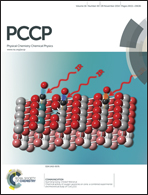The mechanism of tautomerisation and geometric isomerisation in thioformic acid and its water complexes: exploring chemical pathways for water migration†
Abstract
A systematic and automated search for chemical pathways of isomerisation between geometric and tautomeric forms of gas-phase thioformic acid (TFA) and its water complexes is performed using a global reaction route mapping (GRRM) method, and an uncovered pathway for cis–trans isomerisation in the thiol form of TFA has been explored through computations performed at CCSD(T)/6-311++G(2d,2p)//B3LYP/6-311++G(2d,2p) level of the coupled cluster and density functional theories. To explore the routes for water migration, a detailed analysis of complexes of TFA with a single-water molecule is presented. Notably, during the isomerisation process in TFA, a positive catalytic effect of water was observed that can arise either by the stabilization of the reactant and/or of the transition state through extensive hydrogen bonding. Interesting behavior of isomeric forms of TFA along the pathways analysed is revealed through the Gibbs free-energy change and its temperature-dependence. The cis form of TFA(thiol) in the complexes of TFA with a single-water molecule is found to be thermodynamically equally feasible as the trans form which though is known to be the most dominating among the isomeric forms of TFA. Besides these, various complexes of TFA with two-water molecules have also been explored to study the hydrogen-bonding interaction through natural bond-orbital (NBO) analysis. The complexes of TFA with two-water molecules have also been characterized using spectral features including vibrational frequency analysis, and the effect of complexation has been observed by noting frequency shift.



 Please wait while we load your content...
Please wait while we load your content...